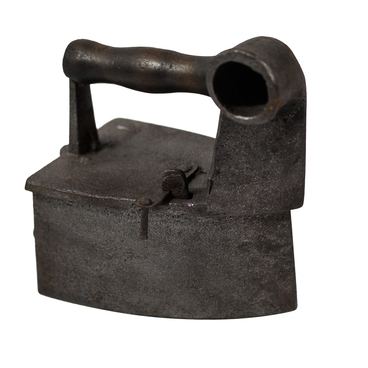This flat iron from the collection of the Nevyansk Historical and Architectural Museum was made in the late 19th or early 20th century by one of the craftsmen who lived and worked at the Nevyansk plant. The iron is wedge-shaped, and its handle is fixed on the top by two cylindrical relief bases. The upper part features a cast ornament. Under the handle, you can still see the rectangular stamp of the plant and the imprints of the obverse which fits the reverse of the medal of the 1896 All-Russian Industrial and Art Exhibition in Nizhny Novgorod.
Flat iron
Creation period
Late 19th – early 20th century
Dimensions
17 cm x 13.5 cm
Technique
Cast iron, casting
Collection
6
Open in app#1
Flat iron
#9
#11
The first irons appeared in ancient times. In the 4th century BC in Ancient Greece, clothes were smoothed using a hot metal rod, which resembled a rolling pin. Lightly processed heated cobblestones were also used. In the 18th and 19th centuries, irons already had a shape close to the modern one.
#13
In Russia, irons began to be used in the early 17th century. Prior to this, clothes were wound on a rolling pin, after which they were carefully rolled several times with a rubel: a long wooden plate with ridges on the lower surface and a handle at the end. This ironing technique was preserved in some villages until the late 20th century.
#15
The 17th century saw the advent of irons that were filled with burning coals. The most common were flat irons, which were heated in a Russian stove.
#16
The solid-cast flat iron replaced the steam or charcoal iron. It was heavier and could weigh up to 10 kilos. The larger ones were used to iron coarse fabrics, and miniature ones were used for thinner and lighter fabrics. Often two irons were used at the same time: while the housewife worked with one, the second was heated on the stove.
#17
Metal irons at that time were quite expensive. Their presence in the family was considered a sign of wealth. Irons were often passed down from one generation to the next. Sometimes they were even included in the bride’s dowry. In Nevyansk they could be bought at the fair, which was held twice a year, or at the market, which took place every Sunday. Both local craftsmen and visitors from other Ural and Siberian cities sold irons.
#18
State Autonomous Cultural Institution of the Sverdlovsk Region "Nevyansk State Historical and Architectural Museum"
read morehide
00:00
00:00
1x
Flat iron
Creation period
Late 19th – early 20th century
Dimensions
17 cm x 13.5 cm
Technique
Cast iron, casting
Collection
6
Open in app
Share

